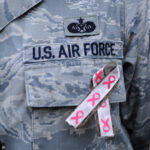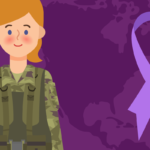In 2012, Nicole Malachowski was at the top of her professional game: a combat veteran and commander of an F-15 E fighter squadron who was the first woman named to the service’s Air Demonstration Squadron, the Thunderbirds.
But while leading her unit in North Carolina, Malachowski fell ill with symptoms of fatigue, brain fog, muscle aches and joint pain so severe that she removed herself from flying.
Although she had nearly instant access to a primary care doctor and specialists through the Department of Defense’s (DOD) medical system, it took her 1,525 days to receive a diagnosis of Lyme disease from Massachusetts General Hospital — outside the military health system.
“I went to endless military doctors. After three years of horrible symptoms, I saw a top Navy doctor who looked at me for five minutes and diagnosed me with fibromyalgia,” Malachowski said. “He said, ‘You have been a high-performing woman in a male-dominated career field for a long time. Maybe this is your body’s way of telling you it’s time to retire.’”
The DOD manages a $56 billion health system that includes 51 medical centers, hundreds of clinics and a private care system. It serves 9.4 million beneficiaries, including active-duty troops, family members and military retirees.
Nearly 230,000 women serve in the U.S. military — making up nearly 17% of active-duty forces — while thousands more are wives and children of service members. But the system still struggles to adequately provide women’s healthcare, especially for female troops.
The situation has the potential to be a national security issue, according to Ginger Miller, founder and CEO of Women Veterans Interactive Foundation, an organization designed to empower women in their post-military lives.
“Servicewomen need different types of treatment, because they have different types of issues. You can’t just give them a couple of Motrin and tell them to sit down,” Miller said.
Gaps in military healthcare
An analysis conducted in 1994 by the Defense Women’s Health Research Program found that servicewomen faced gaps in healthcare in areas such as musculoskeletal injuries, gynecological health and “reproductive hazards,” defined as circumstances or exposures that could make it hard to get pregnant. In 2015 — 21 years later — another DOD analysis identified the same issues and added contraception roadblocks and mental health services to the list of shortfalls.
The number of women in the service has increased in the last two decades, and in the Iraq and Afghanistan wars, women held 10% of all deployed positions. More than one in four students at military service academies are women.
Defense Health Board members say that while some improvements have occurred, with DOD creating the Defense Health Agency’s Women and Infant Clinical Community and the Women’s Health Research Interest Group, more work needs to be done.
“An integrated, enterprise-wide approach to women’s health is essential to military readiness of female service members,” board members wrote in a presentation in April 2019.
The Government Accountability Office (GAO) reported in May 2020 that the likelihood of women leaving the military for any reason is 28% higher than men. According to the GAO, some of the reasons women separate include sexual assault and family planning, which are affected by access to fertility services and maternity leave and care.
Miller noted that, while rape or sexual assault are traumatic crimes that require a diligent law enforcement response, they also require quality physical and mental healthcare responses as well.
“We do hear stories of women getting out of the military because they’ve had health issues — a lot of them related to military sexual trauma and post-traumatic stress disorder [PTSD] because women feel they’re not getting the support they need in the military,” Miller said.
Military retention concerns
With the Army, Navy, Air Force and Marines facing recruiting challenges and retention issues, ensuring that all service members have access to their promised healthcare and benefits is extremely important, Malachowski said.
“This is a major issue for retention, not just for the service members but for military families. Access to care has consistently been a problem in my story — delays in care caused me to have a chronic and permanent disability,” she said.
The military health system faces the same issues of racial and gender bias that exist in the American health system, Miller noted. A poll conducted in August by National Public Radio, the Robert Wood Johnson Foundation and the Harvard T.H. Chan School of Public Health found that two in 10 respondents had trouble accessing care during the pandemic. And an even higher number of Black respondents — four out of 10 — reported facing challenges getting care for serious illnesses.
The poll noted that most of the people who had trouble getting care had health insurance. This points to the conclusion that a lack of insurance was not the primary barrier, and that race and ethnicity played a role. This lines up with the fact that 15% of Black respondents and 14% of Latino respondents said they had trouble accessing care or were disrespected or turned away as a result of their race or ethnicity.
Miller said she saw similar biases against female service members and minorities when she was in the Navy years ago, and hears about it from currently serving members.
“It’s real,” Miller said. “Women are equal. We need equal healthcare.”
Medical challenges that servicewomen face
Military women have complex medical needs that women in the civilian workforce often don’t have to deal with. For example, musculoskeletal injuries from physical work or poorly fitting equipment, chronic urinary tract infections (UTIs) while deployed to locations where going to the bathroom is challenging, poor access to contraception, and trouble conceiving as a result of being separated from a partner or being exposed to battlefield conditions or pollutants.
Mental health is a major concern as well. While the DOD has made an effort to reduce the stigma of seeking psychological care, troops are still hesitant, Miller said.
“A lot of the servicewomen may not want to speak up to say that they have some of these issues because they’re afraid to be judged, and on the other hand, the military makes members feel like you’ve got to tough it out. But [women’s] systems simply aren’t made to tough it out,” Miller said, referring to the impact of deployment on women’s genitourinary systems, which can easily get infections as a result of field conditions and dehydration, as well as the effects of training, poorly fitting gear and heavy equipment on their musculoskeletal systems.
A 2022 study by Rand Corp., a Washington, D.C.-based think tank, found that when comparing the health outcomes of male troops versus female, the disparities are mostly the result of gender discrimination, sexual harassment and sexual assault.
Solve those issues and the U.S. military would be a healthier, more fit, ready force. Malachowski agreed: “Military medicine is very well suited for acute battlefield medicine, but when it comes to complex, chronic or mysterious illnesses, forget about it. Processes and procedures actually do exist in the regulations to help patients get care that may be specialized or outside of the medical system. But there needs to be more educational awareness of that.”
















